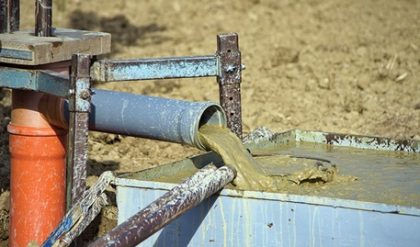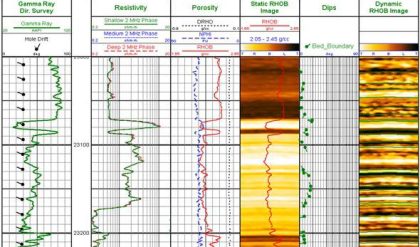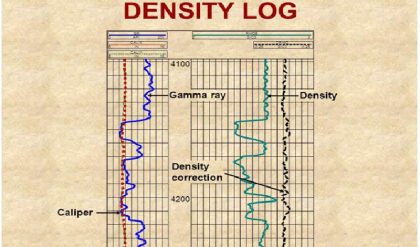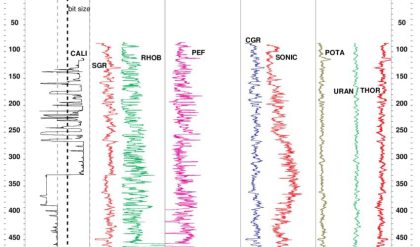Oil well drilling is a complex operation and the drilling industry engages the services of personnel and a complicated array of machinery and materials to drill an oil/gas well to depths greater than 6000 meters, The drilling industry has seen technological progress, however, these advances have not changed the fact that, besides the use of complicated machinery, successful drilling is a result of tremendous team effort. Numerous personnel from the operating company and several service companies work together to drill and complete an oil/gas well.
A drilling rig is used to drill a hole, and this requires qualified personnel, different types of equipment the application of a great variety of technology.
When a drilling project is commenced, two goals must be achieved:
- To drill and finish the well in a safe manner (personal injuries, technical problems) and according to its purpose;
- To complete the project with minimum cost.
The overall costs of the well must be optimized and this optimization may influence where the well is drilled (onshore – extended reach or offshore above reservoir), the drilling technology applied (conventional or slim-hole drilling) as well as the evaluation procedures run to gather subsurface information for future drilling projects.
Rotary drilling is the most efficient technology applied in the oil and gas industry.
It is a drilling technology that relies on continuous circular rotation of the bit to break rocks, while drilling fluids circulate through the bit and up the wellbore to the surface, making possible to drill safely and efficiently the well.
Rotary drilling rig
The drilling rig consists of a set of equipment and machinery located on the so-called drilling site and normally the rig is not owned by the oil company but by drilling service companies, which hire out the rig complete with operators and which construct the well according to the client’s specifications.
The most important items of equipment are shown in the figure below.

Drilling Rig Systems

Main Equipment of a Rotary Drilling Rig
A drilling rig is composed of different systems:
- The hosting system
- It the set of equipment necessary for handling any material inside the well(drill string and the casing);
- It consists of a structural part (derrick/mast and substructure), the complex of the crown and travelling block, the drawworks (hoist) and the drilling line;
- The substructure is the supporting base for the derrick, the drawworks and the rotary table, and constitutes the working floor for operations, or drilling floor.

The Hosting System

The Derrick Types

The Mast Types
- The rotating system
- The rotating system allow the rotation of the drill string, and it consists of the rotary table, the kelly and the swivel;
- In modern rigs, a top drive groups together the functions of the above three items of equipment.

The Kelly System

The Top Drive System
- The circulation system
- The circulation system consists of mud pumps, distribution lines, and the mud cleaning and accumulation system;
- It is the closed hydraulic circuit which allows the mud to flow from the surface to the bottom of the hole, inside the drill string, and subsequently back to the surface, in the drillstring borehole annulus;
- The mud from the hole has to have the cuttings removed before being reinjected to the bottom of the hole and the mud pumps supply the energy necessary for circulation;
- The choice of drilling fluid is dictated mainly by the characteristics of the formations to be drilled, by their drillability and reactivity to water, and by problems of disposing of the spent fluid;
- Drilling fluids have many functions to perform including:
- The removal and transport to the surface of the cuttings produced by the bit;
- The control of the formation pressure;
- The prevention of caving and collapse of the borehole walls;
- The slowing down of the sedimentation of the cuttings when circulation stops;
- The cooling and lubrication of the drilling equipment;
- The sources of geological and stratigraphic information.
- Drilling fluids are subdivided into three major classes:
- Water based muds;
- Oil based muds;
- Air -based muds (used to reduce bottomhole pressure, to avoid circulation losses in surface layers, or to limit damage to productive formations).

The Circulating System (from University of Texas)
- The power generation system
- A power generation system is needed to run the machines driving the main components of the rig and it is provided by diesel engines, diesel-electric engines;
- Power is transferred from the engines to the different rig systems by belts, chains, and drive shafts on a mechanical rig, or by generatedDC electrical power on an electric rig and it is distributed to the rotary table and mud pumps and to the drawworks.

Drilling Rig Power Generation System
The drill string
The drill string is an assemblage of hollow pipes of circular section, extending from the surface to the bottom of the hole.
It has three functions:
- it takes the drilling bit to the bottom of the hole, while transmitting its rotation and its vertical load to it;
- it permits the circulation of the drilling fluid to the bottom of the hole;
- it guides and controls the trajectory of the hole.
Starting from the surface, drill string consists of:
- a kelly, drill pipes, intermediate pipes, drill collars and a number of accessory items of equipment (stabilizers, reamers, jars, shock absorbers, downhole motors, etc.), and it ends with the bit;
- The bit is connected on to the end of the drill string – it is the tool that bores the rock, transforming it into fragments called cuttings, which are then transported to the surface by the drilling fluid;
- The choice of the type of bit depends on the hardness, abrasiveness and drillability of the rock formation.

Main Components of a Drill String (from National Oilwell Varco)

An Insert Tricone Bit

A PDC Bit
Casing
- Casing is a steel tube that starts from the surface and goes down to the bottom of the hole, and is rigidly connected to the rocky formation using cement slurry, which also guarantees hydraulic insulation.
- The casing supports the walls of the hole and prevents the migration of fluids from layers at high pressure to ones at low pressure.
- Furthermore, the casing enables circulation losses to be eliminated, protects the hole against damage caused by impacts and friction of the drill string, acts as an anchorage for the safety equipment (BOPs, Blow Out Preventers) and, in the case of a production well, also for the Christmas tree.
- The dimensions of the tubes, types of thread and joints are standardized (API standards)and the functions and names of the various casings vary according to the depth.
- Starting from the uppermost and largest casing, first comes the conductor pipe, then the surface casing and the intermediate casing, and finally the production casing.

Casing Strings (from Schlumberger)
Cementing
Cementing is the operation of pumping a cement slurry between the casing and the formation, and can be performed by injection into the annulus from inside the casing.
The cementing (primary cementing) serves to rigidly connect the casing to the formation and to guarantee the hydraulic insulation of the various formations, preventing the migration of the fluids from layers at high pore pressure to those at low pressure.
The centralization of the casing is particularly important, as the geometry of the well is seldom regular, but tortuous and with a variable diameter.
All other cementing operations carried out after the primary operation, either to correct an earlier not very effective cementing operation, or for other purposes (repair of a damaged casing, setting cement plugs, squeeze operations, and so on), are called secondary cementing.

Primary cementing
The wellhead and safety equipment (BOP)
The wellhead and the safety equipment are the valve units that allow the well to be insulated from the outside environment.
In this way it is possible to control effectively and safely the pressures that develop in the well when it is in hydraulic communication with the subsurface formations.
The wellhead is a fixed unit that connects the various casings set inside the well.
If it is a producing well, this unit remains there until the end of drilling, and is completed with the production head or Christmas tree.
The safety equipment, known as Blow Out Preventers (BOPs), are large valves located on the wellhead during drilling operations able to fully shut-in the well in case of need (Well control).
BOPs on onshore rigs and fixed offshore rigs (platforms, jack-ups) are installed on the surface wellhead, while for floating rigs they are located on the seabed, on the subsea wellhead.
The shut-in of the well is necessary when hydraulic control is lost, i.e. when the pressure of the underground fluids is greater than that of the bottomhole mud.
A standard BOP stack consists, starting from below, of:
- one or more spools for connection to the wellhead; a dual function ram preventer; a single-function ram preventer; an annular blowout preventer; a lateral tube, which conveys the outgoing mud from the well to the shaker; a number of lateral connections (kill line and choke line), necessary for operations to restore hydraulic balance after well control problems.
The BOP stack has the following functions:
- to shut-in the well around any type of equipment; to permit pumping of the mud, with the well closed by means of the kill line; to discharge through the choke line any fluids that might have accidentally entered the well; and to allow the vertical movement of the string, upwards or downwards, when the well is closed (stripping).

Land BOP Stack

A Subsea BOP Stack
Directional drilling
Directional drilling is the science of deviating a well bore along a planned course to a subsurface target whose location is a given lateral distance and direction from the vertical.
At a specified vertical depth, this definition is the fundamental concept of “controlled” directional drilling even in a well bore which is held as close to vertical as possible as well as a deliberately planned deviation from the vertical.
Directional drilling is, therefore, a technique that makes it possible to reach deep mining targets even at a considerable horizontal distance from the location of the surface rig.
Each of these shapes meets specific operational demands.
During the drilling process, on the basis of the information as and when it is relayed to the drilling engineer, both the inclination and the direction can still be modified (navigational drilling).
Applications of directional drilling
Directional drilling is used in a number of operational situations, the most recurrent of which are listed below:
- Sidetracking, Inaccessible Locations, Salt Dome Drilling, Fault Controlling, Multiple Exploration Wells from a Single Well-bore, Offshore Multiwell Drilling, Relief Well, Horizontal Wells
Configurations of a directional well
Directional and horizontal wells are drilled on the basis of a design that follows precise technical criteria in order to obtain a regular and ‘practicable’ hole both at the drilling stage and during all of its subsequent productive life.
Broadly speaking, the drilling of a directional or horizontal well has the following operating stages:
Beginning of the drilling, Deviation of the well, Constant inclination, S-shaped hole(if the design envisages an S-shaped hole to reach the target, or a decrease in the inclination angle to a pre-determined value, at the established depth the inclination of the hole path begins to be decreased by a prefixed gradient – Drop-Off Rate).

Typical Well Profiles and Terminology (from National Oilwell Varco)
Configurations of a horizontal well
Horizontal drilling is the process of drilling a well from the surface to a subsurface location just above the target oil or gas reservoir called the “kickoff point”, then deviating the well bore from the vertical plane around a curve to intersect the reservoir at the “entry point” with a near-horizontal inclination, and remaining within the reservoir until the desired bottom hole location is reached.
Oil companies are often able to develop a reservoir with a significantly smaller number of wells, since each horizontal well can drain a larger rock volume than a vertical well could.
The aggregate surface “footprint” of an oil or gas operation can be reduced by use of horizontal wells.
The use of a horizontal well may reverse or significantly delay the onset of production problems that engender low production rates, low recovery efficiencies, and/or premature well abandonment.
Horizontal wells can schematically be subdivided into three main categories according to the angular gradient with which the horizontal section is reached:
- Long-radius wells use standard technology to drill directional wells and the BUR may vary between 3° and 8° every 30 m and requires 2 or 3 sections;
- Medium-radius wells use standard equipment, although suitably modified to face the problems arising during horizontal drilling and the BUR increases significantly compared to the preceding case(between 8° and 20° every 30m);
- Short-radius wells make possible a build-up rates ranging between 30° and 60° every m and therefore has the possibility to arrive to the horizontal section in less than 3 m.

Typical Horizontal Wells Profiles (from Oil and Gas Journal)
Directional drilling tools for deviation
There are several systems to establish and carry out the deviation and some of them have been highly improved in recent times, particularly since the carrying out of extended-reach horizontal wells or those having a particular shape have become more common.
The drilling industry has gone from using the whipstock and jetting to the systematic use of bottomhole motors, steerable systems and the geosteering.
In general, wellbore trajectory is controlled by the type of bottom hole assembly used and the weight on the bit.
The bottom hole assembly consists of several components:
- Heavy-weight drill pipe, Drill collars, Stabilizers, Subs
A typical surface rotated bottomhole assembly (BHA) is made of stabilizers, drill collars and measurement-while-drilling (MWD) equipment.
The placement and size of stabilizers control inclination (deviation angle from the vertical).
Assemblies can be designed to build angle, hold it steady or drop angle.
Steerable drilling system and geosteering
Rotary assemblies do not permit close control of wellbore azimuth (compass bearing of the wellbore with respect to magnetic North).
This control is usually achieved with a downhole motor with a bent housing, which allow the rotation to be applied to the bit alone.
Downhole motors are hydraulic machines at the end of the string, screwed directly onto the bit, and the entire mud flow goes through them, part of the mud pressure being converted into rotary motion and torque.
In this way, the rotation necessary for operating the bit is supplied by the downhole motor, while the whole drill string can remain stationary, or may be rotated, if necessary, with the rotary table or the top drive.
The use of such motors is essential both for directional drilling and for the application of modern techniques for controlling the vertical trajectory of wells.
Downhole motors, an integral part of the BHA, are axial-flow machines of tubular shape and are similar in size to a drill collar.
These motors do not form part of the standard equipment of the rig, but are hired from service companies, which also supply the personnel specialized in using them and which look after their maintenance.
Positive Displacement Motors are rotating, closed-type volumetric machines and their internal architecture is in fact they are Moineau pumps made to operate in the opposite direction, whereby the motor shaft is caused to rotate by forcing the mud through it under pressure.
The mud, which is forced past the stator and the rotor, fills these cavities, and causes the rotor to rotate continuously, thus causing the rotation of the bit alone.

Schematic of a PDM Motor

Steerable BHA (from Schlumberger)
A steerable drilling system is made up of a PDM, with a MWD equipment, which provides in real time the data of interest to the driller (such as inclination, direction, pressure, temperature, real weight on the drill bit, torque stress, etc.) or the LWD equipment is installed.
The latter makes it possible to send to the surface, not only the information mentioned above, but also geological data (the gamma ray log, the resistivity, density and sonic logs, etc.).
The coupling of sensors providing information on the course of the well trajectory, in real time and in a continuous way, with logs characterizing the formations from a geological viewpoint, goes under the name of geosteering.

A Typical Geosteering BHA (from Baker Hughes)
This technique makes it possible to navigate, in the true sense of the word, in the subsurface following the most suitable route to reach the prefixed targets.
Rotary steereable system – RSS
Conventional directional drilling techniques require the use of bent housing downhole motors to be oriented in the borehole and “slid” along the borehole without rotation of the drillstring to achieve a change in the well’s trajectory.
Periods of this “slide” drilling are interspersed with periods of rotary drilling to achieve the desired three-dimensional wellbore trajectory.
Rotary steerable drilling is a technology that enables full three-dimensional directional drilling control to be performed while drilling with continuous drillstring rotation from surface (no “slide” drilling is necessary). This capability requires a special BHA component above the bit to direct the well path in the desired direction, maintaining the orientation of the drilling trajectory independent of the rotation of the BHA and drillpipe above it.
This component is the rotary steering device. How the different available rotary steering devices accomplish their task varies from relatively simple gravity-based orientation systems to more sophisticated flexure of internal drive shafts or flexure of the lower portion of the BHA by application of forces from pads against the borehole wall.

Rotary steerable system designs
Some systems also employ automatic drilling modes where the wellbore is automatically steered using closed loop control systems programmed in the downhole tool.
These systems deliver significant benefits in wellbore placement and overall wellbore quality compared to non automated systems.
They combine the precise directional control of steerable motors with the high penetration rates, hole cleaning advantages, and reduced friction of rotary drilling techniques.
In addition to differences in the mechanisms, which these systems use to physically steer the well, there are also differences in the manner in which systems are communicated with from surface and also the level of integration with the MWD and LWD systems employed in the BHA.
Efficient communication from surface results in significant time savings and a higher level of integration with MWD/LWD systems allows positioning of LWD sensors close to the bit while simultaneously minimizing BHA length and increasing reliability.

Example of Rotary Steerable Closed Loop System (from Oil and Gas Journal)






Comments are closed.